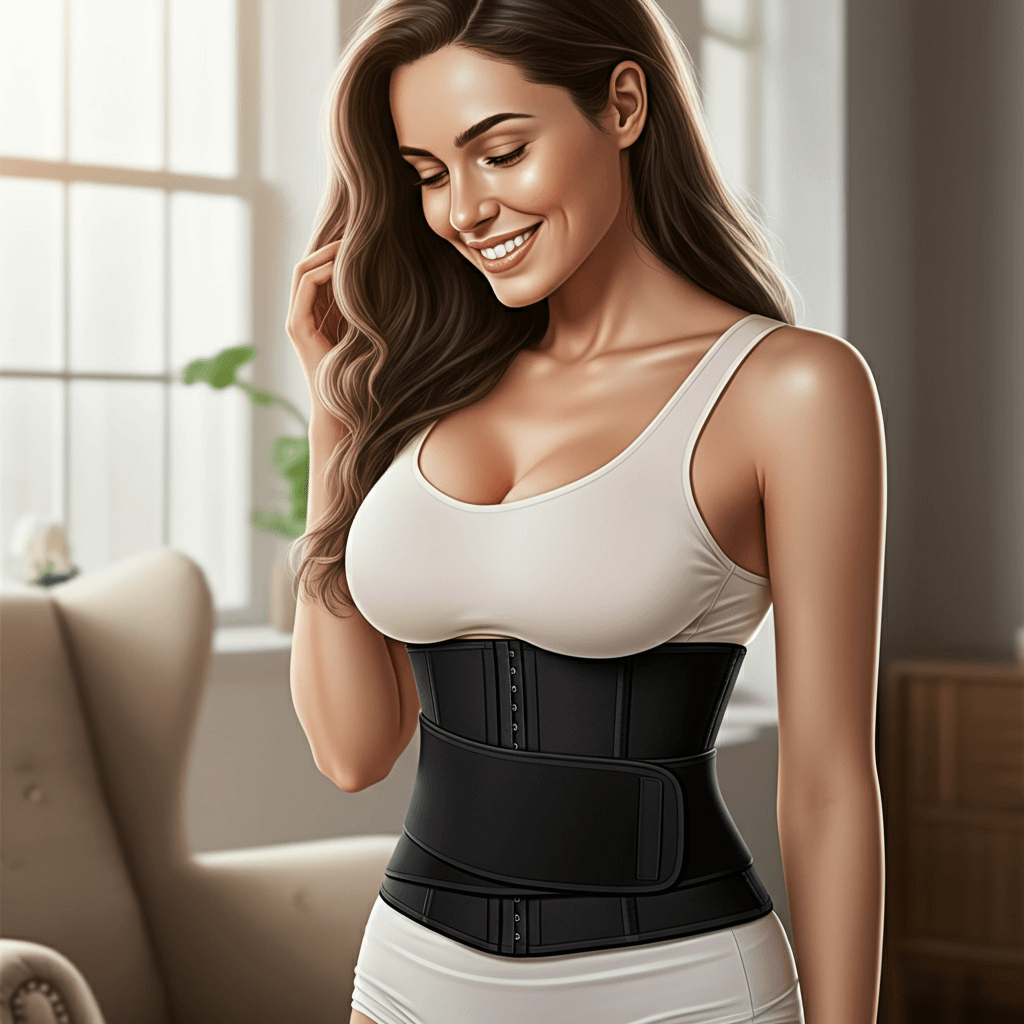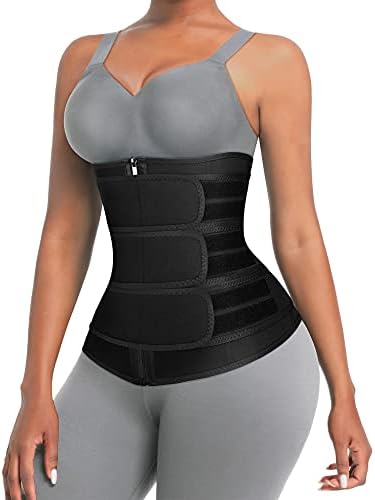
Waist trainers are tight-fitting undergarments made from materials like spandex and latex, designed to temporarily shape the waist into an hourglass figure. Often used to enhance curves and provide temporary waist reduction, they also come with cautionary notes regarding potential health risks such as breathing issues, weakened core muscles, and digestive issues.
When considering whether to work out with a waist trainer, it’s crucial to weigh the pros and cons.
- Benefits may include improved posture support, increased motivation, and potential weight loss,
- while risks involve restricted movement, potential discomfort, and skin irritation.
Safety tips suggest ensuring a proper fit, limiting wear duration, and avoiding high-intensity workouts. Additionally, exploring alternatives like shapewear or engaging in core-strengthening exercises can provide safe, effective body shaping without the downsides associated with waist trainers. Consulting with a doctor before starting a new fitness regimen involving waist trainers is advised.
Key Takeaways
- Waist trainers are tight-fitting garments designed to reduce waist size and create an hourglass figure using powerful compression.
-
Benefits of waist trainers may include:
✨ Temporary slimming 👆 Posture improvement 💪 Postpartum supportbut potential risks and side effects should be considered before use.
- When using a waist trainer for exercise, it is important to follow proper safety precautions and consider alternatives such as other shapewear options. Real people’s experiences and reviews can provide insight into effectiveness and long-term use.
Table of Contents
What are Waist Trainers?
Waist trainers are tight-fitting undergarments designed to shape the waist into an hourglass figure using materials like spandex and latex.
Waist trainers compress the waist area to alter body shape temporarily and can reduce appetite by compressing the stomach.
The Pros and Cons of Waist Trainers
Waist trainers are compression garments used to create a slimmer waist and hourglass shape.
Pros of waist trainers include enhancing the appearance of curves, providing temporary waist reduction, and tightening the waist. For more information, you can read about the pros, cons, and safety tips of wearing waist trainers while exercising.
Cons of waist trainers involve potential health risks such as breathing issues, digestive problems, weakened core muscles, and the potential for internal organs compression.
Balancing aesthetic goals with health considerations is essential when using waist trainers.
Possible Risks and Side Effects
Waist trainers pose health risks such as compressing internal organs, interfering with natural functions, and causing digestive issues like acid reflux, heartburn, and decreased gut motility.
Consultation with a medical professional is recommended before using waist trainers to prevent potential harm.
Using Waist Trainers for Exercise
Waist trainers are compression garments worn during exercise to support core strength and potentially enhance an hourglass shape.
Using waist trainers for exercise can restrict movement and breathing, potentially leading to reduced workout effectiveness and physical activity levels.
Waist trainers may provide temporary support but can hinder full range of motion and overall workout effectiveness.
How they Affect Workouts
Waist trainers affect workouts by compressing the stomach and limiting movement, which can impact breathing and performance. This can lead to decreased muscle strength and reduced workout efficiency.
During high-intensity exercises, waist trainers can restrict breathing and movement. This restriction can also lead to discomfort and possible health risks such as abdominal pain and digestive issues.
For activities like yoga or pilates, waist trainers can hinder flexibility and breath control, making it difficult to perform certain poses and exercises effectively.
Waist trainers may offer core support in less intensive workouts but should not replace natural core strength development. Regularly engaging in core-strengthening exercises is essential for long-term health.
Safety Tips for Exercising with a Waist Trainer
Safety tips for exercising with a waist trainer include:
- Ensuring proper fit
- Limiting duration
- Avoiding high-intensity workouts
- Monitoring breathing and comfort
Use a waist trainer that allows full movement and supports core strength without causing discomfort or restricted breathing.
Proper Use and Precautions
Proper use of waist trainers involves ensuring a comfortable fit without excessive tightness, allowing free movement and proper breathing. Choosing synthetic materials like spandex and nylon can provide flexibility and support.
Precautions include limiting the duration of wear and avoiding use during high-intensity workouts.
Choosing breathable materials like elastic fabric helps prevent overheating and skin irritation.
Gradually increasing wear time helps users acclimate to waist trainers.
Regular cleaning and storing in a cool, dry place maintain the product’s longevity. Following these steps can help avoid issues like skin irritation and fabric degradation.
Alternatives to Waist Trainers
Alternatives to waist trainers include shapewear like high-waist briefs, compression leggings, and corset belts.
Other options involve engaging in core-strengthening exercises, yoga, and Pilates to naturally shape and tone the body.
Supportive workout gear such as sports bras, sweatbands, and posture correctors also offers additional comfort and shape without the risks associated with waist trainers.
Other Shapewear Options
Shapewear options beyond waist trainers include bodysuits, compression shorts, and high-waisted shaping panties.
Bodysuits offer seamless support and can be worn under clothing, made from breathable materials for comfort.
Compression shorts provide smooth lines under dresses and skirts, typically made from spandex and polyester blends.
High-waisted shaping panties target abdominal support, creating a sleek silhouette without sacrificing comfort.
Real People’s Experiences with Waist Trainers
Real people’s experiences with waist trainers include benefits such as improved body shape, increased confidence, and a motivational boost, but some users report discomfort and health risks from prolonged use.
Experiences vary; while some users achieve desired body contouring, others experience negative effects, emphasizing the importance of cautious use.
Customer Reviews and Testimonials
Customer reviews and testimonials for waist trainers highlight benefits like achieving an hourglass shape, improving body confidence, and reducing water weight, but also note concerns about comfort and health effects.
Positive feedback praises waist trainers for enhancing posture and providing a flattering silhouette, while negative reviews mention discomfort during long wear and issues with breathing and digestion.
Overall, reviews indicate that while waist trainers can improve appearance, potential buyers should consider comfort, health, and consulting with a nutritionist when choosing to use them.
Frequently Asked Questions
1. Can I work out with a waist trainer on? Are there any medical concerns?
Yes, you can work out with a waist trainer on, but it is not recommended for every type of exercise. It is important to consult with a fitness professional or a doctor before incorporating a waist trainer into your workout routine.
2. What are the pros of working out with a waist trainer?
Working out with a waist trainer can help improve posture, provide extra support to the core muscles, and increase sweat production, potentially leading to temporary weight loss. However, be cautious of relying on temporary results and ensure a balanced diet to support your fitness goals.
3. What are the cons of working out with a waist trainer?
Some potential cons of working out with a waist trainer include restricted breathing, uncomfortable sweating, skin irritation, and potential damage to internal organs if worn too tightly or for extended periods of time.
4. Are there any safety tips for working out with a waist trainer?
It is important to choose a waist trainer that fits comfortably and does not restrict your breathing. It is also recommended to start with shorter workout sessions and gradually increase the duration as your body gets used to the waist trainer. Additionally, exercise regularly with proper workout gear to avoid potential health risks.
5. Where can I buy a waist trainer and which brands are the best?
Waist trainers can be purchased online, in stores, or through a direct sales representative. Some popular brands include Skims, Hourglass Angel, and Ann Chery. Look for waist trainers with laces, hooks, and elastic fabric for better adjustability and comfort.
6. Are waist trainers safe for everyone to use?
Waist trainers are not recommended for everyone, especially those with preexisting medical conditions, such as breathing problems or digestive issues. It is important to consult with a doctor before incorporating a waist trainer into your workout routine, particularly for those with medical concerns or postpartum support needs.






